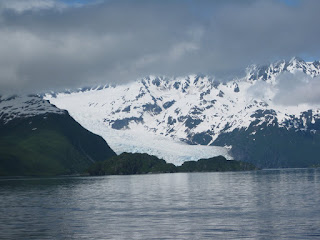Homer - Halibut Fishing Capital of the World
Me at the lovely overlook site.
From Seward we had to drive north to Sterling Highway, and that took us across the Kenai Peninsula and down the western coast to Homer. We arrived on a sunny day and stopped at the welcoming overlook for get our first glimpse at Homer and the Homer Spit.
Homer Spit, stretching out into the Kachemak Bay... What a view!
Another breathtaking way to take in the view!
We could see the four mile long Spit below us. The Spit is the remains of an ancient moraine left by a glacier retreating into the Kenai Mountains. Ah, more glacial trivia, I love it.
Two archeological finds have revealed that the Spit was used by humans long before written history. Pacific Eskimo are known to have lived here thousands of years ago. Other Indians moved into Cook Inlet about 1,000 years ago, followed by Russian explorers, trappers and traders who arrived in the late 1700's. The Russians added their culture to the mix, and many locations and landmarks now bare Russian names.
Our destination was a city campground way out on the end of the Spit.
The view from our campsite at nine o'clock in the morning.
The view from our campsite at nine o'clock at night.
Once again we were blessed with waterfront property and a view to die for. Across the bay are the mountains, forests and glaciers of Kachemak Bay State Park. The park has 400,000 acres of pristine wilderness and we wanted to take our kayaks over there. However, a water taxi would have charged us $70.00 each person .... each way .... so we had to let go of that idea.
These mountains are part of the chain that encompass "The Ring of Fire", volcanos that sit on the tectonic plate rimming the Pacific Ocean. From the Kenai Peninsula you can see five active volcanos. Mounts Spurr, Redoubt, Iliamna, Augustine and Douglas make up the easternmost part of the Aleutian volcanic arc. Of these, Mount Augustine poses the greatest threat to Homer and the Kachemak Bay communities.
The Salty Dawg Saloon.
One of the many fresh seafood/charter shops.
The Spit was bustling with activity. Boardwalks and shops of all kinds line the road. There are fine restaurants and seafood shacks, and many shops for the tourist. You can find everything from luxury hotels ($180/night), and fancy RV parks ($78/night), to the city campgrounds where we stayed.( $15/night).
The tip of the Spit.
At the very tip of the Spit people lined up night (with the help of the midnight sun) and day to catch bottom fish. The fish were "chummed in" by a nearby cannery, and you couldn't lose. We saw people walk away with huge buckets full of flounder!
One of the ever-busy fish cleaning stations in our camping area.
People were not the only ones enjoying the easy catches.
While we were in Homer we met a wonderful couple from Capitola, CA., Peg and Craig. It was nice to find another couple who liked to play. David and Craig went out on a half-day halibut charter one morning and both caught their limit of 2 fish. We were there over the Fourth of July weekend and shared a wonderful traditional celebration. First we had a BBQ at the local Elks Lodge which offered spit roasted pig as well as the usual hot dogs and hamburgers. Then we watched the 4th of July parade.
Nola, David, Peg and Craig
Waiting for the parade along Pioneer Street.
Happy 4th of July!
By this time we had been on our Alaskan Adventure for six weeks and seen some spectacular scenery, met some fabulous people, and had incredible experiences. This day I waved my little flag for "spacious skies"... for "purple mountain majesties" ... for "the crowning of brotherhood" and for the grace shed on America.
How blessed we are to have the freedom to live our lives the way we choose and let others do the same.


























































